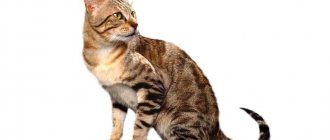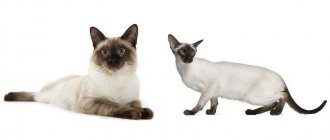People who do not particularly understand cat breeds call such cats Siamese, although, on the other hand, this breed has gained worldwide recognition among felinologists quite recently. In addition, there are some similarities between these breeds, but despite this, Thai cats are an example of how optimal the proportions of animal body parts can be. In fact, this is not the main reason that animals of this breed are very popular.
Along with a harmonious exterior, this cat combines playfulness, as well as nobility, high sophistication, as well as spontaneity, tenderness, affection for humans, and the hunting instinct.
History of Thai cats
The first mentions of cats with a light body and darkened ears, muzzle, paws and tail date back to the 14th–15th centuries. Then in Ayutthaya they created the “Book of Poems about Cats”, where the Vichien Mae - the ancestors of the Thais - were drawn. These cats were called royal, because ordinary people were forbidden to keep them - only temples and the family of the monarch had such a right. The Vichien Mae were considered sacred, guardians of the souls of the departed and protectors from the forces of evil.
In his book about travels around Russia, written in the 18th century, the German traveler Peter Simon Pallas mentioned a cat he met in the settlement of Insar, Penza province, whose description was very similar to Vichien Mae. It is very likely that she escaped from traders and, by crossing with Russian cats, gave rise to all Russian color-point breeds (Neva Masquerade, Kurilian Bobtail, etc.).
Thai and Siamese cats are “sisters,” but they are different breeds.
In Europe, this cat officially appeared only in the 1860s, since the king of Siam had previously prohibited the export of sacred animals from the country. There are two versions of how Vichien Mae got to Europe, but both of them are associated with Great Britain:
- the first version says that the cats were presented to the British general Owen Gould by the Siamese king as a sign of special favor. In the UK, color-point cats with bright blue eyes have created a real sensation. At the exhibition in the Ice Palace, Vichien Mai became the main stars;
- According to the second version, the ancestors of the Thais were brought to Europe in 1967 by the widow of a British officer and part-time governess of the heirs of the King of Siam. At the end of her service, she received from the king several sacred cats, which she really liked. They became the first Vichien Mae in Europe.
In 1971, the King of Siam sent 11 cats to Europe as gifts for high-ranking officials. Breeding began with them.
The ancestors of the population are considered to be the pair Pho and Miya, which translated from Thai means “Father” and “Mother”. They belonged to breeder Lilian Valley-Gould, who divided the sacred cats of Siam into two groups: “round-cheeked and strong” and “thin, marten-faced.” Pho belonged to the first type, and Miya to the second. From them came two breeds - Thai and Siamese, only the first took after the father, and the second took after the mother.
In 1885, the feline couple Pho and Mia gave birth to three kittens, whose names were Duen Ngai, Kalohom and Kchromata. At the exhibition that same year, the animals created a real sensation. Miya became the winner among shorthair cats, and Pho took second place.
The “progenitor” of Thai cats was the cat Pho, from whom they inherited the exterior
In 1892, the first official standard for Thais and Siamese was created by Harrison Ware, the “father of felinology.” It listed only one color point color - seal point. All the rest, like chocolate, red, purple and others were considered defective. A little later, chocolate point was recognized, and then other colors. Throughout the existence of the Thai cat, the breed standard has changed, but only slightly. Its final version was installed in 1990.
How to name a kitten
The character of Thai cats and the history of the breed provide the owner with many options for choosing a name for his pet.
You can choose from Thai names that are pronounced with the emphasis on the last syllable:
| Nickname for a boy kitten | Nickname for a girl's kitten |
| Aron, Vaen, Det, Kosum, Kitty Krysi, Chris, Mai, Manoj, Nai, Nok, Phen, Khan, Mongkut, Narong, Niran, Thaksin, Lek, Dao, Nok, Kai, Samon, Kosum, Apple, Yu | Agum, Dara, Dao, Spark, Kama, Mali, Bunsi, Buppa, Mali, Vaen, Nari, Num |
These nicknames are just hints. They say that all you have to do is look into the sky-blue eyes of a kitten, and he will come up with an idea.
Appearance
The ideal Thai cat is a medium-sized cat, of a strong but elegant type, with a round body and good muscles:
- her head is beautifully rounded, without depressions or flattening;
- forehead, cheeks and profile with a soft convex line, have strong outlines;
- The slightly curved nose should preferably be at eye level. Stop is unacceptable. The tips of the nose and chin form a straight line;
- the muzzle is not angular or pointed, but slightly rounded, proportional to the size of the head, well developed, emphasizing the roundness of the external contours;
- the neck is medium or short, strong and muscular;
- The ears are medium in size, wide at the base, with a rounded line on the inside. They are located more on the sides of the head than on the top. Very small ear tassels are acceptable;
- The eyes are of medium size, almond-shaped, with the upper eyelid having the shape of a crescent, and the lower one having a rounded curve. Set wide and slightly oblique (inner corners slightly lower than outer corners);
- eye color is bright, blue, uniform;
- the body is medium to large in size, males weigh about 5–6 kg, females 3–4 kg. Foreign body type with developed, strong muscles. Solid appearance with good structure and slight curvature of the back line in profile from the chest to the rear;
- The limbs are muscular, proportional to the body in length, and form a rectangle with the body. The feet are slightly rounded;
- the tail is of medium length, proportional to the body, somewhat wider at the base, pointed at the end;
- The coat is thin, close-lying, but not flat, with a slight undercoat.
Externally, the Thai cat has changed little since the beginning of the 20th century.
Common faults found in Thai cats include:
- strabismus;
- dark spots on the stomach, back and sides;
- white stripes or individual “stitching” hairs on points (brindle);
- knots at the end of the tail;
- sloping or too massive chin;
- presence of white spots or toes;
- eye color other than blue;
- crease of the tail.
Color
The standard allows all acromelanic (color-point) colors, but without white spots (type ... & white):
- seal point;
- blue point;
- cake point;
- cream point;
- chocolate point;
- lilac point;
- red point;
- seal tabby point;
- blue tabby point;
- red tabby point;
- tortie-tabby-point.
Silver variations are also possible (for example, seal-silver-point, red-silver-tabby point, etc.).
Color-pointed animals should not be given seafood or liver as they cause their coats to darken.
Photo gallery: colors of Thai cats
The most common color of Thais is seal point.
The markings of the Thai Blue Point cat are deep gray.
Only females are endowed with the tortie point color.
The cream point color is characterized by delicate beige spots on a white background.
Chocolate point cats have dark markings against an ivory coat.
The pink tint of the spots can only be distinguished in daylight
The red point color is characterized by red spots on the white coat.
The muzzle, paws and tail of Thai seal tabby point cats are decorated with stripes
The blue tabby point color suggests the presence of gray stripes
Red Tabby Pointed Thais have red stripes, especially clearly visible on the tail.
Color Dot Genetics
The CS gene is responsible for the characteristic non-standard coloring, which reacts to body temperature in its various places. Pigmentation appears in cooler areas around the extremities: paws, tail, ears and nose.
The dark pointed coat tone is passed on to the kitten from parents who have the recessive CS gene.
The next hereditary feature is the blue eyes of a cat, characteristic of albinos. It has been noted that the brighter this trait, the richer the tone of the fur on the mask and the more contrasting the difference with the color of the body - the structure of the main gene C suppresses darkening in parts with elevated temperatures, and the hairs on the limbs are controlled by the CS trait, which is activated in these places.
The final formation of a kitten's color occurs between six months and 10 months.
Interesting: In the future, even the weather and living conditions affect the color saturation - the cooler the air, the more contrasting the color-point pigmentation of the cat looks.
Character and behavioral characteristics
There is a widespread belief among people that all Thai cats are vicious and unfriendly. However, this is not at all true. Thai owners call them nothing less than eternal children: they are always ready to play, active, inquisitive, sensitive to the owner, emotional, receptive and understanding. Anger as such is not inherent in them by nature. They feel a person’s mood, understand when to support and when to move away and not impose. However, Thais are cats with character. They are individual not only due to their appearance, but also to their behavior.
Sometimes, in an effort to dominate, Thais become overly aggressive, but such moments must be stopped
Thais are very easy to educate; they grasp everything literally on the fly. They also treat strangers well and are trusting. They become strongly attached to children, but at the same time they know how to “control themselves” - they will never bite or scratch without a good reason. However, it is better for the child to learn how to properly handle a cat.
Thais treat other animals coolly at first, but once they get used to it, they can become best friends even with a dog, provided that it is friendly. Males get along with each other without problems, but only if they are castrated.
Tabby point
A variety of dots in which a pigmented pattern is added to the main color. In this case, the mask does not cover the muzzle with a continuous fill, but is distributed symmetrically over it:
- the letter M on the forehead usually reaches the eye line or descends below it;
- spots in the roots of the mustache and in the lip area;
- the eyes are outlined with pigmented glasses;
- around the nose there is a contour to match the points.
This cat breed is also distinguished by its striped tail, on which the primary and secondary colors alternate.
Content Features
The Thai cat is an active and curious breed, so there should not be many breakable, small or sharp objects in the apartment. Your pet should be given at least 2-3 hours a day. It is advisable that she has her own play complex, for example, combined with a scratching post.
Nutrition
Veterinarians do not recommend mixing “natural” and factory-made food, but if you choose this option, remember that at least 6 hours should pass between meals.
Features of feeding natural food
Products needed by a Thai cat include:
- meat - beef, chicken, rabbit, turkey, veal;
- fermented milk products - yogurt without fruit additives, curdled milk, kefir;
- cereals - rice, semolina, oatmeal;
- vegetables - zucchini, cabbage, pumpkin;
- eggs (twice a week).
One serving should contain three to four parts of boiled meat, one part of porridge and half of vegetable puree.
Meat should be given to a Thai cat boiled so that it does not become infected with worms.
Selection of industrial feed
It is recommended to feed your pets with high-quality holistic, premium and super-premium products. Suitable for kittens:
- Farmina Cimiao Kitten (Italy, super-premium);
- Innova Cat and Kitten (USA, holistic);
- Chicken Soup for the Soul (USA, premium);
- ProNature, Sweet Potato Chicken (Canada, Holistic);
- Royal Canin Babycat Milk (milk formula), Babycat Instinctive (France, premium).
Adult cats will like:
- Chicken Soup for the Soul (Canada, premium);
- Innova Cat and Kitten (USA, holistic);
- Cimiao Delicious (Italy, super-premium);
- Pronature Holistic with turkey and cranberry (Canada, holistic);
- Royal Canin Indoor 27 (France, premium).
By choosing high-quality food for your pet that contains all the necessary vitamins and microelements, you can save yourself the headache of creating a balanced menu.
Wool hygiene
Thai cats are a short-haired breed, so caring for their coat will not cause much trouble. It is enough to comb the fur once a week (3 times during shedding) with a rubberized brush, and then remove the remaining hairs by stroking the cat with wet hands. You can also use a slicker once a week during shedding.
A Thai cat needs to be bathed once every 3 months, as needed and before the exhibition. To do this you need to use shampoo-conditioner. When washing, the water should reach the cat's belly. First, you need to wet the fur, then apply shampoo and lather, and then rinse thoroughly.
Shampoos for short-haired cats are suitable for Thais:
- BioVax;
- Royal Groom Shine and moisture;
- Rolf Club Premium shampoo-conditioner;
- Phytoelite Veda;
- Doctor ZOO.
Thai cats do not need frequent bathing
Care for claws, teeth, eyes, ears
A Thai cat's ears should be cleaned using special drops designed for this purpose. The procedure is carried out every 4–5 days. The animal's eyes are wiped with a damp piece of natural fabric daily. Teeth should be brushed once every 3 days with a silicone finger brush and toothpaste for cats.
Nails are trimmed as the cuticle grows. Only the transparent part of the claw needs to be cut off. But if a cat seriously damages the furniture, then it makes sense to use anti-scratch products. They are harmless, fit on the claw and reliably protect furniture from damage.
Contrary to popular belief, anti-scratch products do not harm cats.
Video: about the appearance, character of the Thai cat and care features
Nutrition
The feeding place must be permanent. When organizing meals, you should choose a natural diet or ready-made food and stick to one type, without mixing them. Food of any kind should be warm.
A natural diet includes boiled beef and chicken, boiled egg yolks, and low-fat fermented milk products. You should limit your consumption of seafood and liver when eating natural foods. Additionally include vegetables and fruits. Thais often eat them raw. If the pet does not want to eat the vegetables whole, then they are grated on a fine grater and mixed with the meat.
A vitamin complex is periodically added to food. An adult animal needs two meals a day. Babies are fed 5-6 times a day in small portions to replenish energy reserves. Clean water should always be available, especially when using dry food.
Watch the water
Health and illness
The genes of the Thai cat contain strong immunity, so they rarely get sick, often living up to 18–20 years. But this breed also has typical diseases.
Breast tumor
The tumor can be benign or malignant. It usually affects cats over seven years of age; “young” cats are very rarely affected.
Symptoms of breast cancer include:
- thinness that appears in later stages, decreased activity, lack of appetite;
- signs of inflammation in the mammary glands, increase in size;
- the appearance of ulcers that periodically break out;
- pain when touching the glands.
If the tumor is benign, it can simply be removed through surgery. Malignant neoplasms in the initial stages are treated in the same way, but with chemotherapy. At stages 3 and 4, surgery is practically useless.
Thai cats are long-lived, often living up to 20 years
Hydrocephalus
Hydrocephalus, or dropsy of the brain, is a congenital disease that can be caused by heredity, birth trauma, or intrauterine infection. It can be detected after birth. Symptoms include:
- increased head size;
- reduced body size;
- neurological seizures starting at 8–12 weeks.
It is impossible to completely cure hydrocephalus, but competent therapy in the early stages can make a cat’s life easier.
Felinologists have found that the Thai cat scores on average 9 out of 10 points on the cat intelligence scale
Lungs' cancer
Lung cancer can affect a cat at any age. Its symptoms:
- in the early stages, frequent and dry cough;
- a little later - with sputum, pus and blood;
- severe shortness of breath, not in any way related to activity (the cat convulsively gasps for air, wheezes).
Surgery for lung cancer is most successful at stages 1 and 2, then chemotherapy is prescribed. The advanced disease is fatal and cannot be treated.
Cat cough can be caused not only by cancer, but also by asthma, heart failure, and helminthiasis.
Diabetes
In cats, diabetes is divided into two types:
- The first is extremely rare and involves the complete death of beta cells.
- The second type is characterized by a decrease in their amount necessary for the production of insulin.
Symptoms of the disease include:
- frequent urination;
- strong thirst;
- increased appetite while losing weight.
The risk group includes males, individuals who are obese and have passed the five-year mark. Diabetes is diagnosed if there is an increased and stable level of glucose in the cat’s blood and urine. For an accurate diagnosis, sometimes you need to take tests up to 5 times a day.
Diabetes in cats can be treated and alleviated. For this purpose, a special diet is developed, hypoglycemic drugs and insulin injections are prescribed. Obese cats benefit from weight loss. You should also stop taking all medications except those prescribed by your veterinarian.
The Thai cat is a classic breed, so it has very good immunity
Heart disease
Heart defects can be of two types:
- Innate. It is extremely rare and occurs most often due to the following pathologies:
- heart valves - in this case they simply do not close and push blood during contraction into the aorta, as a result of which the heart can simply stop;
- Botal duct - the prognosis depends on the size of the hole between the chambers of the heart: the smaller it is, the more chances the cat has to survive and lead a full life.
- Acquired. As a rule, this is cardiomyopathy - a pathology associated with an increase in the size of the heart, rhythm disturbances and the subsequent development of heart failure.
Serious defects are operated on extremely rarely, and uncomplicated defects will not interfere with the life of the animal
Cardiomyopathy
There are four types of this disease:
- Hypertrophic. The most common and is characterized by thickening of the walls of the heart, which causes it to work worse and is not supplied with oxygen.
- Dilatational. At the same time, the volume of the organ increases, but the walls remain the same thickness. The condition of the heart is very similar to a rag, because of this oxygen starvation occurs.
- Restrictive. The heart ceases to be elastic, as a result of which the body lacks oxygen. Cats rarely live longer than two years with this type of cardiomyopathy.
- Intermediate. Combines symptoms of several types of cardiomyopathy. This is the most dangerous and severe form of the disease.
Symptoms can be detected in the early stages by a veterinarian:
- galloping heart rhythm;
- arrhythmia;
- pulse pathology;
- heart murmurs;
- hypertension.
Cardiomyopathy is often observed against the background of other diseases: acromegaly, bull's heart, lymphoma. It may occur due to bad heredity. In this case, by curing the underlying disease, cardiomyopathy can be significantly alleviated and even eliminated.
Given the complex pathogenesis of cardiomyopathy, treatment should always be prescribed by a professional veterinarian
Breeding and organization of nursery
Thai cats mature very early - by six months many are ready for mating. But the most optimal time to carry it out is a year and a half.
Mating
When selecting a partner for mating, the following rules must be observed:
- a cat and a female cat must match each other's blood type. The female of group A is mated with males A and B, males B with females A and B, females B with males B, males A with females A;
- It is better for novice breeders to buy a cat: if it has a defect, it can be corrected by a cat;
- It is advisable to choose a partner for a Thai cat of the same color. Crossing with other breeds is prohibited;
- animals must be vaccinated, dewormed and checked by a veterinarian;
- It is imperative to check the divorce mark from the exhibition, received no more than a year ago (for males - “excellent” in the open category, for females - at least “very good” in the junior or open category), or a title certificate of any date;
- the whole process must take place on the territory of the groom;
- for the time that the cat lives with the cat’s owners, you need to transport there all the necessary things (food, bed, tray and bowls);
- mating is carried out on the 2nd–3rd day of estrus and must be confirmed by a contract.
If your pet is knitting for the first time, it is better to find an experienced partner.
Pregnancy
You can determine whether a cat is pregnant by the third week after mating by a number of signs:
- swollen, bright pink nipples;
- changes in preferences, behavior and habits;
- vomiting in the morning;
- enlargement of the abdomen.
At earlier stages, pregnancy can only be determined using ultrasound. But it is recommended to resort to it in extreme cases, since there is a risk of harming the cat and kittens.
Thai cats are reverent mothers, ready to protect their kittens at any cost.
Note to the breeder
A person who decides to open a Thai cattery must have a very good understanding of the breed:
- Each nursery is registered with the club and operates according to the rules of the felinological organization to which it belongs. Therefore, first read the rules of several organizations and choose the best one for yourself;
- registration is confirmed by a document. The club seal can also be officially issued;
- Taking felinological courses will greatly help you in your activities as a breeder. The diploma will allow you to register litters and evaluate cats yourself. Each member of the club must be noted in its documentation;
- All litters are subject to activation. The kitten is assigned a metric, which can be changed to a pedigree if desired, and a certificate with a four-digit number, which is entered in the stud book;
- cats need enough space. If you are planning to open a nursery as a long-term business, then it would be a good idea to build a separate room for it.
The nursery must have a separate room equipped with everything necessary
Tips for choosing a kitten
Choosing a kitten begins with finding a responsible breeder, as this is a guarantee of a successful purchase. Here are some tips to help you find your baby:
- take a kitten into your home at the age of 3 months - until this period it should feed on mother’s milk;
- decide for what purpose you need it: for an exhibition - show class. The best animals that fully comply with the standard;
- for breeding - breed class. Also meet the standard, but not as bright as the show cats;
- for the soul - pet class. Cats that have significant flaws (for Thais these are white spots on the body, squint, heavy or oriental body type). Usually a note is made in the pedigree: “Without the right to breed.”
- the eyes do not water and do not fester;
The choice of a kitten largely depends on the integrity of the breeder
How to choose a kitten
The best time to take a kitten home is at least 2 months old. Exhibition animals are sold after 5-6 months, when the teeth have completely changed. And the best age when you can evaluate the baby’s exterior and exhibition future is 4 months.
The main criteria for choosing a kitten are simple: it must be healthy, be able to go to the toilet on its own, and preferably use a scratching post.
Gender doesn't matter. An uncastrated cat will mark where he likes, and an unsterilized cat will meow loudly and demand love. And such characteristics of the breed as cunning, cunning, and stubbornness are characteristic of both boys and girls. The only cats are more affectionate and careful than cats.
Each Thai breeder has his own price for a kitten. The determining factor of how much a purebred Thai kitten costs is class. For show class pets the highest price is from 25 thousand rubles, breed class – 10 thousand rubles, pet class can be purchased from 5 thousand rubles.











